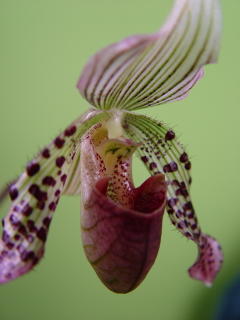I've been trying to understand a bit more about foot-candles tonight to try and find the right amount of light for the Coelogyne clipping I got a couple of weeks ago. The leaves are supposed to be dark green, and were light green when I got it, but are even lighter green now, with a burnt tip on one of them. There is a gorgeous picture of a Coelogyne cristata in bloom
here, with fabulously green leaves. Anyways, I have moved it to a different location with hopefully less light, which I think is what it needs.
From Wikipedia:
"A foot-candle (sometimes designated footcandle; abbreviated fc, lm/ft², or sometimes ft-c) is a non-SI unit of illuminance or light intensity ... Since light intensity is the primary factor in the photosynthesis of plants, horticulturalists often measure and discuss optimum intensity for various plants in foot-candles. Full, unobstructed sunlight has an intensity of approximately 10,000 fc. An overcast day will produce an intensity of around 1,000 fc. The intensity of light near a window can range from 100 to 5,000 fc, depending on the orientation of the window, time of year and latitude."
I have read that the Coelogyne cristata requires between 2000 and 4000 fc, but also as bright light as can be tolerated without burning the leaves. According to this plant information
fact sheet from the New York Botanic Gardens, orchids requiring high light require approximately 3000 fc of light.













